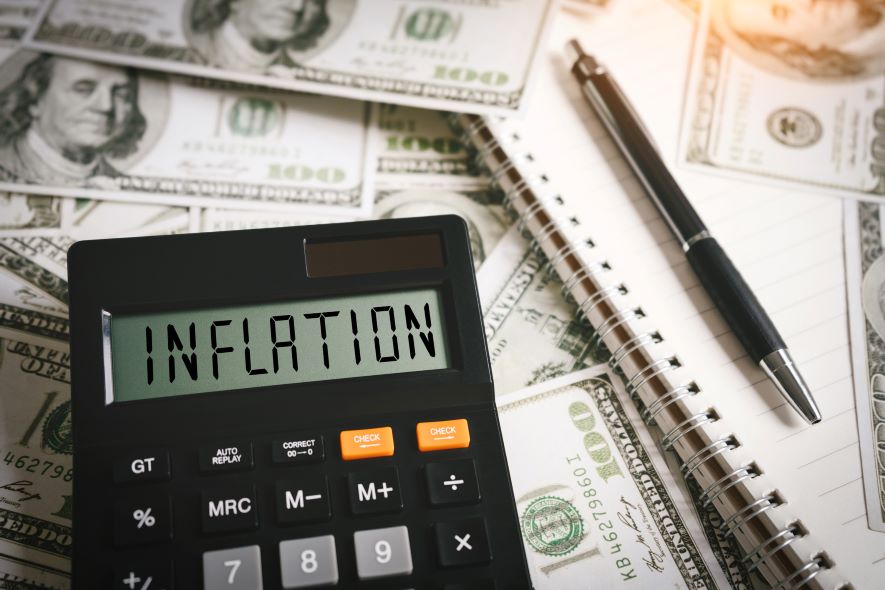Inflation has been rising at record-breaking rates. How can inflation affect a business? What are its drivers, and will it ever slow down? Let’s start by understanding inflation and the various factors that contribute to it. We’ll then discuss how policymakers attempt to control the inflation rate before covering what small business owners can do to preserve their company’s finances during high inflation.
What Is Inflation?

As you look back over the decades, you can easily track rising prices—for a gallon of gas, a cup of coffee, nearly anything you can name. Steadily rising prices are thanks to inflation. What is inflation? It’s when money’s value goes down over time. As the value of each dollar declines, prices go up, or “inflate.” A carton of eggs that used to cost $1.99 may now put you back $3.09. Wages need to keep up with higher costs of living, so an employee who used to make $10 an hour may soon make $15. Typically, this happens at a predictable rate over a period of time, and most economists agree that low, stable inflation can keep an economy healthy. But, as today’s steep price increases show, inflation has been rising at an unpredictable, alarming rate.
Throughout 2021 and into 2022, rising inflation began a steep incline. In the wake of COVID-19’s arrival, the U.S. government hoped to thwart a reactive recession by infusing stimulus money into its economy and using its central bank, the Federal Reserve, to lower interest rates. At the same time, the job market tipped in favor of candidates, driving up wages. With a higher money supply, many people suddenly felt flushed with cash. And they spent it with confidence, increasing consumer demand. But the pandemic had wreaked havoc on the supply chain. Raw material shortages and factory shutdowns slowed manufacturing. And once goods were finally ready, they met transportation delays. The supply side of the global economy floundered. It simply hasn’t kept up with increasingly strong demand.
What Causes Inflation?
Many factors can be cited as causes of inflation, such as a supply and demand imbalance or a growing money supply (even cryptocurrency isn’t immune). The money supply can grow when a country’s banking system increases the amount of available credit or when governments simply print more money. Yet, the recipe for inflation isn’t usually that simple. To explore other factors that lead to inflation, it can be helpful to break them into three main categories: Demand-pull effect, cost-push effect and built-in inflation.
Demand-Pull Effect
When there’s an increase in the money supply, consumer demand often goes up too. During times like these, the demand for goods grows beyond what an economy can produce. This leads to scarcity, so prices rise. Economists call this demand-pull inflation.
Cost-Push Effect
The cost-push effect often starts with higher-priced raw materials, especially ones that are central to supply chains. When businesses experience consistent rises in their production costs, whether due to scarce raw materials or high energy prices, they must eventually push those costs forward by raising prices for their customers. Economists call this cost-push inflation.
Another version of this effect is called “wage-push inflation.” It occurs when rising wages increase the cost to do business and eventually result in higher prices for end buyers.
Built-in Inflation
Most people now expect that inflation is inevitable. With this in mind, people expect their wages to go up. Compensation increases to keep pace with inflation’s higher prices. Then, the economy adjusts to raised wages, and businesses raise prices. This cycle is often called a wage-price spiral. As each factor continues to influence the other, we see built-in inflation.
How Is Inflation Measured?

Economists use a system for measuring inflation to track it accurately over time. The most common measurement for inflation is the Consumer Price Index (CPI). CPI measures purchasing power by tracking the overall prices of a “basket of goods.” These goods include standard items related to a typical American’s cost of living, like transportation, food, medical care and energy. Higher prices contribute to a higher CPI.
When the CPI seems to get out of control, governments will often attempt to combat further inflation and achieve price stability. This can take the form of legally devaluing currency or simply printing more money to keep up with rising prices. Remember, though, that a larger supply of money can further spur inflation.
How Do Policymakers Handle Inflation?
When inflation rates shoot up too quickly, financial policymakers are called to step in. Their specific efforts to slow inflation depend on the factors that led to each case of high inflation. Historically, some policy types have worked better than others.
Disinflationary Policies
Disinflationary policies aim to reduce the inflation rate by shrinking overall money supply. Central banks, like the U.S. Federal Reserve, try to slow the pace of price inflation with tighter monetary policy. This may take the form of raising interest rates or reducing money supply by selling off government securities.
Example of disinflation: After inflation rates soared throughout the 1970s, the U.S. Federal Reserve moved to reduce inflation by increasing federal fund interest rates. In 1978, the inflation rate was 14%, but after raising interest rates to near 20% in 1981, inflation dropped to 3.2% by 1983.
Note: Deflation is a general decrease in price levels which can be harmful to an economy. Disinflation is a temporary slowing of price inflation, often not seen as bad for an economy.
Contractionary Policies
Sometimes policymakers use contractionary policies to reduce inflation. Governments may reduce their spending, especially deficit spending (or spending borrowed money), or the central bank may aim to restrict money supply by increasing interest rates. This can slow overall spending and reduce demand by making it more expensive to borrow money.
Administered Price Setting
Various factors in a capitalist free market usually determine prices, but when inflation gets out of hand, governments may opt to set prices for certain goods to make sure people can afford them. This is called administered price setting. During the 2008 crisis, some governments chose to set prices, to control the costs of gas and food. To do so, though, they had to provide government subsidies to producers and suppliers of price-set goods as a way to offset lost income. Administered price setting is mainly used by centrally-planned governments that reject free market capitalism.
What Is the Impact of Inflation?

Inflation and the efforts to combat it affect everyone. For instance, borrowing money has grown more expensive. That’s because the Federal Reserve has begun to increase benchmark interest rates and reduce its bond holdings. This affects both consumers and businesses. Business owners may feel the impact of inflation on the business environment sooner than consumers, though, because they experience higher supply chain costs and narrower profit margins first — before they raise prices for their customers.
How Inflation Affects Individuals and Families
While businesses may experience inflation sooner, individuals may have to contend with it for longer. That’s because businesses can typically raise their prices more easily than workers can increase their wages. So, while prices can increase quickly, many families and individuals must wait longer for their income to match the higher prices. Many see declines in their purchasing power and their standard of living as a result.
How Inflation Affects Businesses
How does inflation affect businesses? While consumers must contend with rapidly increasing prices and slower-growing wages, businesses must try to balance their supply with consumer demand while also planning for growing expenses, including higher employee pay. And not all businesses will feel it at the same time or in the same way. That’s because inflation moves through the supply chain and may affect certain geographies earlier than or more than others, depending on industry specialization. As business expenses rise, managing cash flow can get more difficult. Many businesses may experience an erosion of purchasing power, shortages of finished products in the market, and rising costs related to borrowing money.
Do Any Businesses Benefit From Inflation?
The impact of inflation on businesses can vary. Some industries may be hit harder by inflation while some industries might thrive. During inflationary times, food manufacturers and real estate tend to do well because food and housing are a necessity. In recent years, healthcare companies have also benefited from the impact of inflation and rising prices.
5 Things Small Businesses Can Do to Protect Against Inflation

No one can be sure when inflation will slow. Small business owners should take a proactive approach to protect their company’s future. You can start preparing for the effects of inflation with the following five tactics.
1. Raise Prices
Small business owners often try to hold off raising prices as long as possible so they won’t deter customers. While this is admirable, it can hurt your business. If your costs continue to creep up, you may finally be forced to make a sudden high price hike. This could put off customers more than gradual, well-communicated increases would. So, keep open communication with your suppliers and plan how to get ahead of impending rises in your business expenses. Whenever possible, share your impending price increases with customers ahead of time. Most people will understand and may even appreciate the heads up.
2. Cut or Reduce Business Expenses
Take a critical look at your budget, especially how you spend your money. Look for things that aren’t necessary for your business to continue, and consider shopping around for your must-haves. Maintain an open dialogue with your suppliers and look for creative ways to negotiate mutually-beneficial contracts.
3. Apply For a Business Loan
If you need help managing your cash flow while dealing with the higher prices that inflation brings, consider securing a business loan. Considering the planned interest rate hikes, sooner may be better.
4. Focus on Retaining Your Employees
Recruiting new employees costs money. Plus, hiring new employees while inflation rates continue to rise also may mean paying increasingly higher wages. Aim to take care of your current employees. Keeping them happy and in place can also maintain a sense of stability during challenging financial times for your business.
5. Automate Where You Can
Automating tasks can save time and reduce costs, so look for repetitive work that you can streamline with automation technology. This can help you stay profitable and survive during difficult hiring markets.
Business owners who successfully adapt during high inflation will not only survive but also gain valuable experience, making them unflappable in overcoming future challenges that may come their way.
Next steps: Interested in more small business marketing tips? Sign up for the Small Biz Ahead newsletter today.






Under the “Disinflationary” paragraph you have listed “. In 1908, the inflation rate was 14%, ” I am guessing this should be 1978.
Thanks for the comment, Gary! We just updated it.